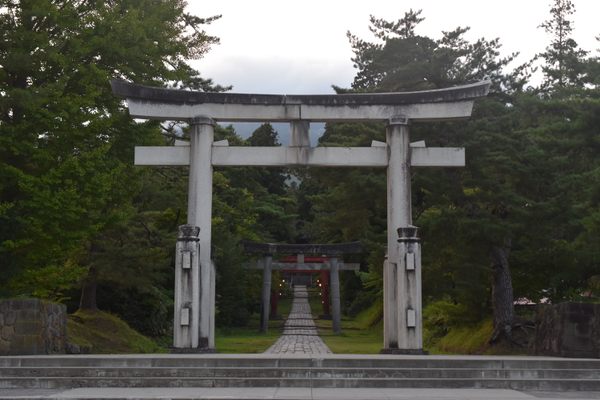Mountain worship is a major aspect of traditional Japanese beliefs, most notably practiced in the Mount Fuji area. In the city of Hirosaki, Aomori Prefecture, it can be found at Mount Iwaki, which rises to a summit elevation of 1,625 meters (5,331 feet). The whole mountain is regarded as the grounds of Iwakiyama Shrine, allegedly founded in 780.
For much of its history, the shrine was a Buddhist temple called Hyakutaku-ji, founded in 1091. It was destroyed by the eruption of Mount Iwaki in 1589 but rebuilt in 1603; it remained a Shinto-Buddhist place of worship until the governmental ban on syncretism took effect around 1873, and has since been a Shinto shrine.
Several structures, including the main building and the inner gate, date back to 1694 and remain in stunning condition. Bright scarlet against the lush foliage, the scenic sight is often compared to that of Nikko, while it shows a different, more mystical face when a fog comes down to embrace it at dawn and sunset. At the back of the shrine starts the hiking path into the rocky forest of Mount Iwaki.
The shrine is also home to several notable legends, including one that inspired a 1915 short story by Mori Ōgai, which in turn was adapted into the famous Japanese film Sansho the Bailiff (1954). It tells the tragic story of a pair of enslaved siblings named Anju and Zushi-ō. Anju, the elder sister who is abused and later killed in the legend, is worshipped as a deity at Mount Iwaki. The worship in Hirosaki was once so intense that people from Tango Province were frowned upon here, as the slavers in the story belonged there.
The site of another legend can be found just beside the main building, as part of a shrine to the “Dragon God of the White Cloud.” It is actually dedicated to Kuniyasu-tamahime, a local dragon-maiden who was chosen by Ōkuninushi-no-kami, one of the major deities of Japanese mythology, to be his wife when he came to bless Mount Iwaki. Worshippers often leave eggs here as offerings (though the shrine encourages them not to), identifying the dragon with a serpent.
The shrine is also known for its unusual lion-dogs. While those divine beasts would usually be flanking and guarding the shrine gate (and Iwakiyama is no exception), you can also find unique lion-dogs climbing up and down the tamagaki fence at this shrine. It is said that the one climbing up may grant you monetary luck while the other, the one climbing down, may bless you with a good relationship.

